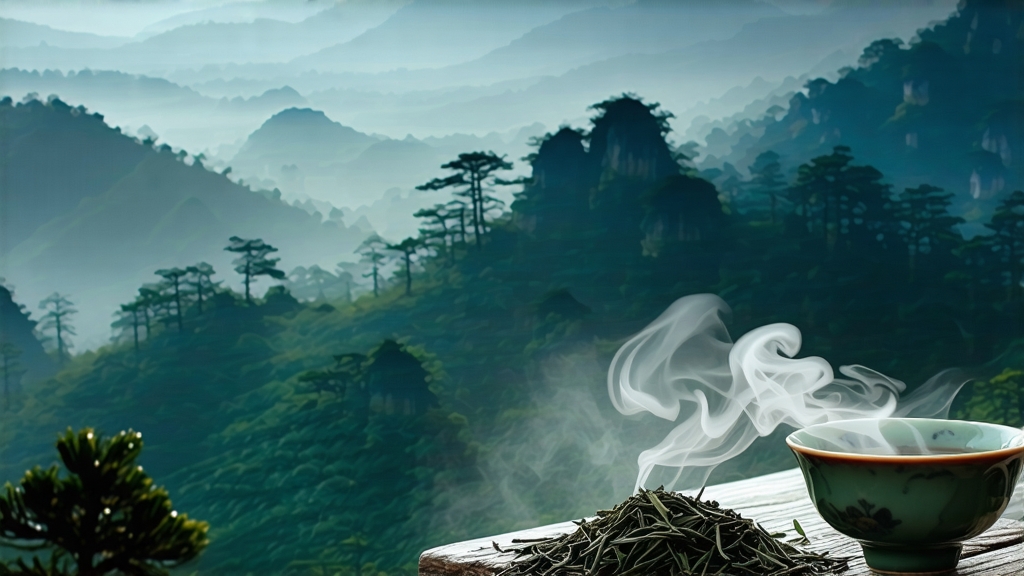
Long before English breakfast blends and Victorian tea salons, the first black tea ever created was born in the rugged Wuyi Mountains of northern Fujian. Locals call it Zheng Shan Xiao Zhong—“proper-mountain small sort”—but the world knows it as Lapsang Souchong. In the early 17th century, fleeing Qing soldiers forced tea farmers to hastily dry their freshly rolled leaves over open pine fires. The accidental smoke infusion produced a coppery liquor so fragrant that Dutch traders carried it to Europe, where it became the prototype for every black tea that followed. Thus, a wartime mishap ignited a global passion for fully oxidized leaf and, some say, the very concept of “black” as opposed to “red” tea.
True Lapsang Souchong can only come from the 600–1,200 m core zone of Tongmu Guan, a protected enclave cloaked in bamboo, cedar, and Masson pine. Here, subtropical mists slow photosynthesis, concentrating amino acids and volatiles in the tender two-leaf-and-a-bud pluck. The cultivar of choice is Xiao Ye Zhong (“small-leaf sort”), a slow-growing landrace whose serrated leaves are barely 2 cm long yet packed with catechins ready to transform into malty theaflavins.
Craft begins the moment pickers descend the misty slopes at dawn. Leaves are withered over crackling pine embers in multilevel wooden sheds called qinglou. For eight to ten hours, gentle smoke drifts upward while artisans shuffle trays every twenty minutes, ensuring each leaf absorbs an even veil of resinous aroma without scorching. Once the leaf loses sixty percent of its moisture, it is rolled on bamboo mats: first crushing cell walls to release enzymes, then kneading to twist the leaf into tight, wiry hooks. Oxidation follows in deep cedar troughs lined with wet cotton; here, the leaf’s chlorophyll oxidizes to black while carotenoids convert to honey, dried-longan, and cocoa notes. A final bake—again over pine charcoal—locks in sweetness and halts oxidation at precisely 92 %. The entire cycle must finish before mountain dew returns at dusk, a rhythm unchanged for four centuries.
Connoisseurs divide Lapsang into two families. Traditional Song-style is smoked, its leaf glossy obsidian with an unmistakable campfire perfume. New-style, developed for the modern Chinese palate, is baked but unsmoked, yielding a golden-orange cup reminiscent of candied peach and roasted sweet potato. Within the smoked category, further nuance emerges: heavily fired “tar lapsang” destined for Russian samovars; medium-smoke “fruit lapsang” prized in Middle Eastern bazaars; and the subtlest “pine-needle lapsang,” reserved for domestic gongfu aficionados who demand whisper-smoke that never masks the cultivar’s natural sugarcane finish.
To brew Lapsang Souchong gongfu style, begin with a 120 ml porcelain gaiwan or Yixing zi-sha teapot seasoned only with black teas. Use 5 g of leaf—about two heaping teaspoons—rinsed for three seconds in 95 °C water to awaken dormant aromatics. The first infusion, ten seconds, releases a liquor the color of Shanxi aged vinegar, its rim shimmering mahogany. Lift the cup to your nose: top notes of pine resin and wintergreen glide into heart notes of longan, dark chocolate, and a fleeting hint of dried lavender. Sip briskly; the soup is silky, almost oily, coating the tongue with a sweetness that arrives three seconds after swallowing, a phenomenon Chinese drinkers call huigan, “returning sweetness.” Subsequent steeps lengthen by five-second increments; a quality Lapsang will yield eight infusions, the smoke receding like morning mist while honey and malt move to the foreground.
Western drinkers often default to boiling water and a three-minute steep, but this extracts tannins that smother subtlety. Instead, treat Lapsang like a fine Burgundy: 90 °C water, 2 g per 250 ml, and precisely two minutes. The resulting cup pairs brilliantly with oily foods—Scottish smoked salmon, Spanish jamón, or a dark-chocolate tart—its phenols cutting fat while echoing smoke.
Professional cupping follows ISO 3103 standards yet adds a Wuyi twist. Three grams of